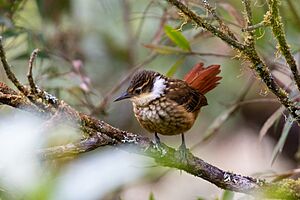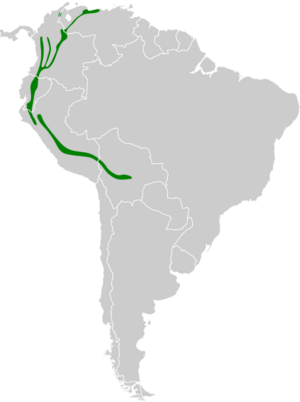Streaked tuftedcheek facts for kids
Quick facts for kids Streaked tuftedcheek |
|
|---|---|
 |
|
| Conservation status | |
| Scientific classification | |
| Genus: |
Pseudocolaptes
|
| Species: |
boissonneautii
|
 |
|
| Synonyms | |
|
Pseudocolaptes boissonneauii |
|
The streaked tuftedcheek (Pseudocolaptes boissonneautii) is a type of passerine bird. It belongs to the ovenbird family called Furnariidae. You can find this bird in countries like Bolivia, Colombia, Ecuador, Peru, and Venezuela.
Contents
About the Streaked Tuftedcheek's Name and Family
Scientists group living things into families and species. This helps us understand how they are related. The streaked tuftedcheek has several different types, which scientists call subspecies. These are like different versions of the same bird, often found in different places.
Some bird experts, like the International Ornithological Committee (IOC), say there are eight subspecies of the streaked tuftedcheek:
- P. b. striaticeps
- P. b. meridae
- P. b. boissonneautii (This is the original type)
- P. b. oberholseri
- P. b. intermedianus
- P. b. medianus
- P. b. auritus
- P. b. carabayae
You might see the bird's scientific name spelled slightly differently sometimes. This is because it was named after a person, Auguste Boissonneau. Some people spell the name of the bird to match his name exactly.
Not long ago, two other birds, the buffy tuftedcheek and the Pacific tuftedcheek, were thought to be the same species as the streaked tuftedcheek. But now, scientists agree they are separate species.
What the Streaked Tuftedcheek Looks Like
The streaked tuftedcheek is a medium-sized bird. It is about 20 to 22 centimeters (8 to 9 inches) long. It weighs between 37 and 62 grams (1.3 to 2.2 ounces). Both male and female birds look similar. However, the female often has a longer beak.
The most special thing about this bird is the fluffy, almost white feathers on the side of its neck. These feathers look like a "tuft." The main type of streaked tuftedcheek, P. b. boissonneautii, has a light, creamy stripe above its eye. It has dark brown feathers around its eyes and white cheeks.
Its head is dark brown with thin, light streaks. Its back is also streaky, and its lower back and tail are a bright reddish-brown color. Its wings are dark brown with reddish edges. The throat is white, and the chest is a light golden color with dark brown edges on the feathers, making it look a bit scaly. The rest of its belly is reddish-brown.
Its eyes are brown. The top part of its beak is black, and the bottom part is grayish-white. Its legs and feet are gray. Young streaked tuftedcheeks look a bit different. They have a shorter beak, a plain black head, and a very reddish belly.
Other subspecies have small differences in their colors or markings. For example, some have less scaling on their chest, or darker heads.
Where the Streaked Tuftedcheek Lives and Its Home
The different subspecies of the streaked tuftedcheek live in specific areas:
- P. b. striaticeps: Lives in the Venezuelan Coastal Range.
- P. b. meridae: Found in the mountains along the border of Colombia and Venezuela.
- P. b. boissonneautii: Lives in the Western and Southern Andes mountains of Colombia.
- P. b. oberholseri: Found from southern Colombia to southern Ecuador.
- P. b. intermedianus: Lives on the western side of the Andes in northwestern Peru.
- P. b. medianus: Found in the Andes mountains of northern Peru.
- P. b. auritus: Lives on the eastern side of the Andes in central Peru.
- P. b. carabayae: Found on the eastern side of the Andes from southern Peru into central Bolivia.
This bird likes to live inside and at the edges of wet mountain forests. These forests are always green. It also lives in "elfin forests," which are misty, high-altitude forests with small, twisted trees. It usually lives at elevations from about 1,700 to 3,200 meters (5,600 to 10,500 feet) high. Sometimes, it can be found as low as 1,450 meters (4,760 feet) or as high as 3,500 meters (11,500 feet).
Behavior
Movement
The streaked tuftedcheek stays in the same area all year round. It does not migrate to different places.
Feeding Habits
Scientists don't know everything about what the streaked tuftedcheek eats. But they do know it eats arthropods (like insects and spiders) and small amphibians (like frogs).
It usually looks for food alone or with its mate. It often joins groups of different bird species that are feeding together. It climbs along branches from the middle of the forest up to the very top. It finds most of its food in epiphytes. These are plants that grow on other plants, like mosses and ferns. It also searches for food in moss and in piles of dead leaves.
Reproduction and Life Cycle
We don't know much about when the streaked tuftedcheek breeds. In Colombia, it seems to finish breeding by September. Scientists believe that these birds stay with one partner for life (monogamous).
They build their nests in old holes made by woodpeckers in dead tree trunks. Not much else is known about how they raise their young.
Vocalization
The streaked tuftedcheek does not sing very often. Its song is quite complex. It starts with sharp "spik" notes. Then it makes a series of whistling, tinkling "tsee" or "che" notes. These notes get a little faster. Finally, it ends with a dry, shaky trill. Sometimes, it stops suddenly with clear notes.
Its call, which it uses to communicate, is a loud, dry "chut" or "chink." It can also sound like a loud "chink!" or "cheeyk!"
Status
The IUCN (International Union for Conservation of Nature) has looked at the streaked tuftedcheek. They have decided it is a species of "Least Concern." This means it is not currently in danger of disappearing.
The bird lives across a very large area. We don't know exactly how many streaked tuftedcheeks there are, but scientists believe their numbers are stable. There are no immediate threats that could harm them. This bird is considered to be common in many parts of its range. It also lives in many protected areas, which helps keep it safe.


